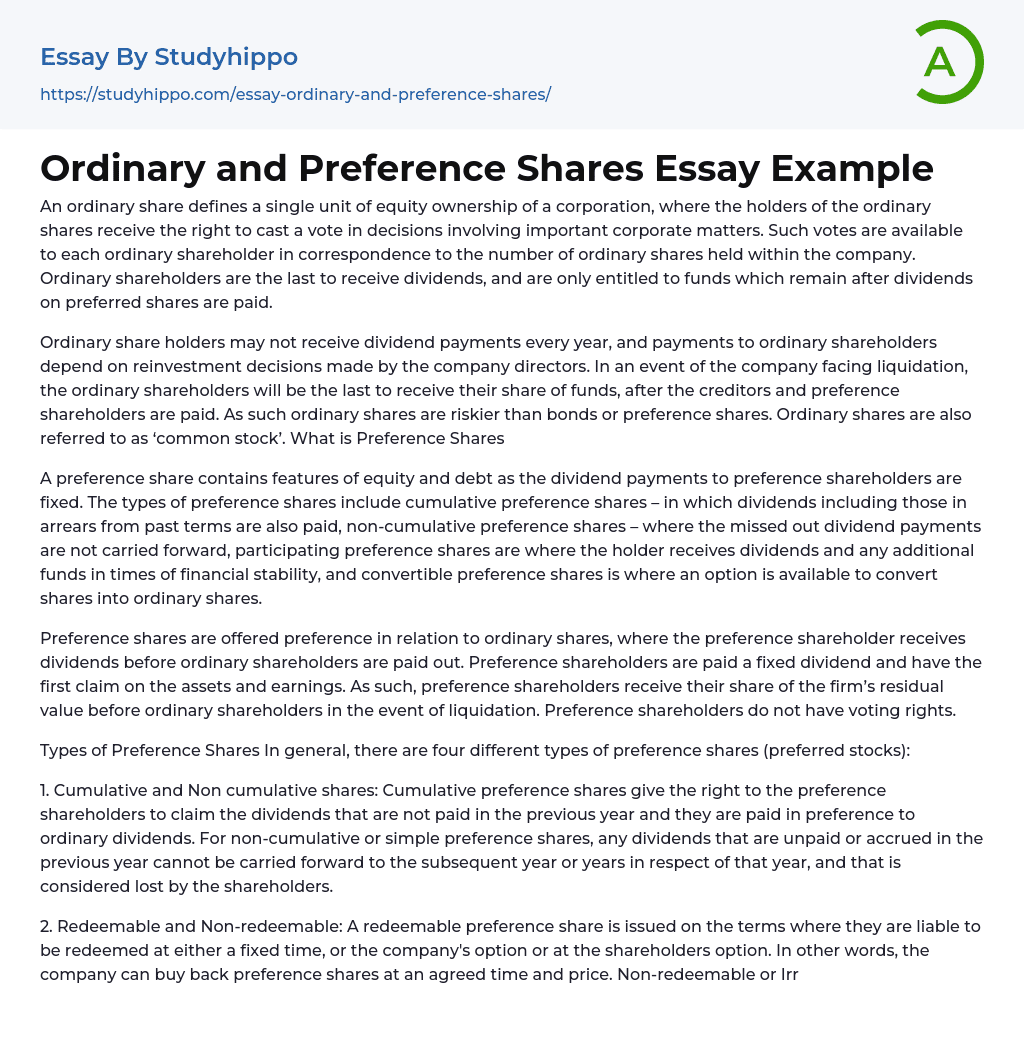An ordinary share defines a single unit of equity ownership of a corporation, where the holders of the ordinary shares receive the right to cast a vote in decisions involving important corporate matters. Such votes are available to each ordinary shareholder in correspondence to the number of ordinary shares held within the company. Ordinary shareholders are the last to receive dividends, and are only entitled to funds which remain after dividends on preferred shares are paid.
Ordinary share holders may not receive dividend payments every year, and payments to ordinary shareholders depend on reinvestment decisions made by the company directors. In an event of the company facing liquidation, the ordinary shareholders will be the last to receive their share of funds, after the creditors and preference shareholders are paid. As such ordinary shares are riskier than bonds or preference shares. O
...rdinary shares are also referred to as ‘common stock’. What is Preference Shares
A preference share contains features of equity and debt as the dividend payments to preference shareholders are fixed. The types of preference shares include cumulative preference shares – in which dividends including those in arrears from past terms are also paid, non-cumulative preference shares – where the missed out dividend payments are not carried forward, participating preference shares are where the holder receives dividends and any additional funds in times of financial stability, and convertible preference shares is where an option is available to convert shares into ordinary shares.
Preference shares are offered preference in relation to ordinary shares, where the preference shareholder receives dividends before ordinary shareholders are paid out. Preference shareholders are paid a fixed
dividend and have the first claim on the assets and earnings. As such, preference shareholders receive their share of the firm’s residual value before ordinary shareholders in the event of liquidation. Preference shareholders do not have voting rights.
Types of Preference Shares In general, there are four different types of preference shares (preferred stocks):
1. Cumulative and Non cumulative shares: Cumulative preference shares give the right to the preference shareholders to claim the dividends that are not paid in the previous year and they are paid in preference to ordinary dividends. For non-cumulative or simple preference shares, any dividends that are unpaid or accrued in the previous year cannot be carried forward to the subsequent year or years in respect of that year, and that is considered lost by the shareholders.
2. Redeemable and Non-redeemable: A redeemable preference share is issued on the terms where they are liable to be redeemed at either a fixed time, or the company's option or at the shareholders option. In other words, the company can buy back preference shares at an agreed time and price. Non-redeemable or Irredeemable preference shares need not be repaid by the company except on winding up of the company. The company is not offering to buy back the securities.
3. Convertible and Non-convertible shares: Convertible Preference Shares are corporate fixed-income securities that the shareholders have the option of converting them into a certain number of ordinary shares after a predetermined time span or on a specific date. Non-Convertible Preference Shares are those which do not have the option of their conversion into the equity shares.
4. Participating and Non-participating
Participating Preference Shares are entitled to a fixed preferential dividend and have the right to participate further in the surplus profits after payment of certain rate of dividend on equity shares. A non-participating share is entitled to fixed rate of dividend only. They do not have such rights to participate or claim for a part in the surplus profits of a company.
- Bank essays
- Banking essays
- Corporate Finance essays
- Credit Card essays
- Currency essays
- Debt essays
- Donation essays
- Enron Scandal essays
- Equity essays
- Financial Accounting essays
- Financial Crisis essays
- Financial News essays
- Financial Ratios essays
- Financial Services essays
- Forecasting essays
- Foreign Exchange Market essays
- Free Market essays
- Gold essays
- Investment essays
- Legacy essays
- Loan essays
- Market Segmentation essays
- Money essays
- Personal finance essays
- Purchasing essays
- Retirement essays
- Shareholder essays
- Stock Market essays
- Supply And Demand essays
- Venture Capital essays
- Accounting essays
- Andrew Carnegie essays
- Automation essays
- Business Cycle essays
- Business Intelligence essays
- Business Model essays
- Business Operations essays
- Business Software essays
- Cooperation essays
- Cooperative essays
- Corporate Social Responsibility essays
- Corporation essays
- Customer Relationship Management essays
- Family Business essays
- Franchising essays
- Harvard Business School essays
- Harvard university essays
- Human Resource Management essays
- Infrastructure essays
- Inventory essays




